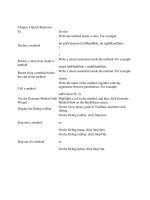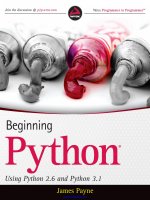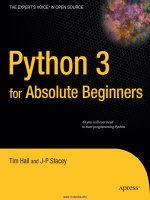Python 3 Beginners Reference
Bạn đang xem bản rút gọn của tài liệu. Xem và tải ngay bản đầy đủ của tài liệu tại đây (331.96 KB, 2 trang )
Alvaro Sebastian
Python 3 Beginner's Reference Cheat Sheet
Main data types
List operations
boolean = True / False
integer = 10
float = 10.01
string = “123abc”
list = [ value1, value2, … ]
dictionary = { key1:value1, key2:value2, …}
Numeric
operators
+
*
/
**
%
//
addition
subtraction
multiplication
division
exponent
modulus
floor division
Boolean
operators
and
or
not
logical AND
logical OR
logical NOT
list = []
list[i] = x
list[i]
list[-1]
list[i:j]
del list[i]
Comparison
operators
defines an empty list
stores x with index i
retrieves the item with index I
retrieves last item
retrieves items in the range i to j
removes the item with index i
Dictionary operations
List methods
list.append(x)
adds x to the end of the list
list.extend(L)
appends L to the end of the list
list.insert(i,x)
inserts x at i position
list.remove(x)
removes the first list item whose
value is x
removes the item at position i and
returns its value
removes all items from the list
list.pop(i)
list.clear()
==
equal
dict = {}
defines an empty dictionary
!=
different
dict[k] = x
stores x associated to key k
>
higher
dict[k]
retrieves the item with key k
<
lower
list.sort()
returns a list of values delimited
by x
returns a string with list values
joined by S
sorts list items
del dict[k]
removes the item with key k
>=
higher or equal
list.reverse()
reverses list elements
<=
lower or equal
list.copy()
returns a copy of the list
Special
characters
#
\n
\<char>
coment
new line
scape char
String methods
string.upper()
string.lower()
string.count(x)
string.find(x)
String operations
string.replace(x,y)
string.strip(x)
string[i]
retrieves character at position i
string.join(L)
string[-1]
retrieves last character
string[i:j]
retrieves characters in range i to j
string.format(x)
converts to uppercase
converts to lowercase
counts how many
times x appears
position of the x first
occurrence
replaces x for y
returns a list of values
delimited by x
returns a string with L
values joined by string
returns a string that
includes formatted x
list.index(x)
list.count(x)
Dictionary methods
dict.keys()
dict.values()
dict.items()
dict.get(k)
dict.pop()
dict.update(D)
dict.clear()
dict.copy()
returns a list of keys
returns a list of values
returns a list of pairs (key,value)
returns the value associtated to
the key k
removes the item associated to
the key and returns its value
adds keys-values (D) to dictionary
removes all keys-values from the
dictionary
returns a copy of the dictionary
Legend: x,y stand for any kind of data values, s for a string, n for a number, L for a list where i,j are list indexes, D stands for a dictionary and k is a dictionary key.
Alvaro Sebastian
Python 3 Beginner's Reference Cheat Sheet
Built-in functions
Conditional
statements
print(x, sep='y')
prints x objects separated by y
input(s)
prints s and waits for an input
that will be returned
len(x)
returns the length of x (s, L or D)
min(L)
returns the minimum value in L
max(L)
returns the maximum value in L
sum(L)
returns the sum of the values in L
range(n1,n2,n)
returns a sequence of numbers
from n1 to n2 in steps of n
Data validation
abs(n)
returns the absolute value of n
try:
round(n1,n)
returns the n1 number rounded
to n digits
type(x)
returns the type of x (string, float,
list, dict …)
str(x)
converts x to string
list(x)
converts x to a list
int(x)
converts x to a integer number
float(x)
converts x to a float number
help(s)
prints help about x
map(function, L)
Applies function to values in L
if <condition> :
<code>
else if <condition> :
<code>
…
else:
<code>
if <value> in <list>:
<code>
except <error>:
<code>
else:
<code>
Loops
while <condition>:
<code>
for <variable> in <list>:
<code>
for <variable> in
range(start,stop,step):
<code>
for key, value in
dict.items():
<code>
Loop control
statements
break
continue
Working with files
and folders
import os
os.getcwd()
os.makedirs(
os.chdir(
os.listdir(
pass
finishes loop
execution
jumps to next
iteration
does nothing
Running external
programs
import os
os.system(<command>)
Functions
def function(
<code>
return <data>
Modules
import module
module.function()
from module import *
function()
Reading and
writing files
f = open(
f.read(<size>)
f.readline(<size>)
f.close()
f = open(
for line in f:
<code>
f.close()
f = open(
f.write(<str>)
f.close()
Legend: x,y stand for any kind of data values, s for a string, n for a number, L for a list where i,j are list indexes, D stands for a dictionary and k is a dictionary key.









